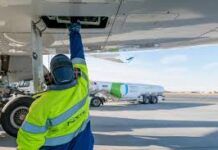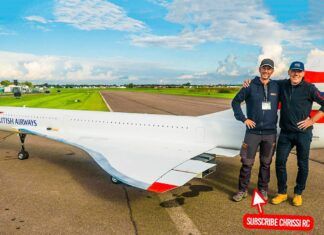At Sun ‘n Fun, after I’d interviewed the soon-to-depart Mooney CEO Vivek Saxena, I found myself fairly perplexed about his comment on seeking the “next-generation piston aircraft.” As he was telling me about that, of course, Diamond was busily introducing it 5000 miles away at Aero. (Reason number 237 why I should have gone to Aero instead.)
As is obvious by now, Diamond’s idea of the next generation goes in perhaps the only direction it can go: bigger, faster, more luxurious and yes, more expensive. And let’s be honest girls, at $900,000-plus, the core of the market represented by the Cirrus SR22 is a million-dollar airplane. I could suck in my editorial breath about this, but I no longer get my pants snagged on the high price of airplanes, for nothing I can possibly say here will change it in the slightest. New certified airplanes are for the wealthy among us and that’s just the way it is.
Mooney came to the realization that the millions it was sinking into new singles for the training market probably would not pay off in high-volume sales. The reason trainers aren’t selling isn’t because there aren’t any good ones, it’s because the world just doesn’t need that many of them. Cessna has been selling a hundred Skyhawks a year, plus or minus, and Piper does about half that many Archers. Throw in a few Diamond DA20s and that’s the sum of it. Well, Cirrus puts SR20s into the training field, too. Still, add it all up and trainers are and always have been low-margin products. The money is made at the upper end of the price tier.
Diamond’s big-cabin DA50s are really a reheated idea. Recall that the idea was trialed at Oshkosh in 2007, but Diamond’s travails with the Thielert diesel fiasco and the world economic meltdown tanked it. While other companies have been satisfied with incremental model changes that are little more than cosmetic redos, Diamond is coming at it with a vengeance, offering three models—one a retract—with three different engines in the mix. By any standard, it’s as gutsy a move as was the diesel-powered DA40 twin introduction in 2002.
They’re going after Cirrus, of course. And Cirrus is probably vulnerable because it has been selling about 300 or so SR-series aircraft a year, but hasn’t introduced anything really new, the attention being siphoned off to complete the SF 50 Vision jet. But is what Diamond has in mind new enough to stimulate the market? Nobody I talk to these days thinks anything will expand the pie by enticing people who otherwise wouldn’t buy an airplane to do so by offering something utterly irresistible. We’ve been in the cannibalistic phase of new aircraft marketing for a while now. Cirrus is probably overdue for its own new model and I suspect it will be one with Continental’s improved FADEC engine, plus a diesel option.
With the right sales apparatus, I think Diamond can find 50 to 100 sales a year for a near-million-dollar single in the world market, if not the rich vein of the North American market. But they will need to invest in sales and marketing because Cirrus is a lot better at it than Diamond, in my opinion. About three times a year, I get an expensive direct-mail piece from Cirrus imploring me to come for an SR22 demo. If Diamond does that, I’m not on the list. The product is important, but sales is just as critical. Clearly, Cirrus is finding several hundred wealthy GA buyers a year and anyone who hopes to succeed will have to do the same.
When I talked to Diamond’s Christian Dries about the new singles last week, he conceded as much and also said something interesting: “What’s the American saying, if you can’t beat them, join them?” That prefaced his explanation of why the DA50-VII will have a Lycoming TEO-540, the iE2 FADEC engine. Dries said he’s sure it will compete better in North America because gas is cheap here compared to the rest of the world and, as Cirrus owners have shown, buyers will pay eye-watering sticker prices if the performance is there. Having said that, Diamond will still offer an as-yet-uncertified 370-HP diesel from Safran/SMA in lieu of the Lycoming, but I’d be surprised if that found much traction in the U.S.
I didn’t answer the question asking if the DA50 is new enough. Perhaps no one can, but looking back at the success of Cirrus, it was only incrementally new when it appeared in 1999. Yes, it was composite, it had the spin-resistant wing and the BRS system, but it—the SR22, that is, which emerged in 2001—wasn’t any faster than a Mooney Ovation, carried less than a Piper Saratoga or a B36TC Bonanza and had range and endurance with its peers. Yet, its combination of qualities evidently gave buyers the feeling that it was something new and the parachute appealed to spouses who might have been otherwise reluctant to pull the purchase trigger. Indeed, the same sentiment applied to many pilot-buyers themselves.
So the DA50—the top-of-line -VIII model—may have a combination of things to entice buyers. A 200-knot-plus cruise speed, a sophisticated electronically controlled engine, five seats with an option for two more and advanced avionics that will likely include an autoland function, what Dries has called an “electronic parachute.” That gives an aggressive sales force something to work with, I’d wager.
A word here about diesel. My most recent survey of the market indicates that diesel is showing glacial growth in market share. The last time I looked, it was about 10 percent of all new piston aircraft. Since 2010, diesel-powered airplanes have averaged about 14 percent, with a high of 18 percent. This number is rubbery because GAMA includes some (but not all) ASTM-approved aircraft in its piston totals and I haven’t had time to extract the noise from the data. But this much is certain: With its diesel-powered twins, Diamond owns the multi-engine space because the aircraft are so popular as trainers. Diamond has a Lycoming-powered version of the DA42; it hasn’t built one in eight years.
When it introduced the $1.3 million DA62 not quite two years ago, I figured Diamond could sell a few dozen a year. They’re approaching 100 orders. That tells me that like Cirrus, Diamond’s combination of good performance, payload and smooth-running, economical diesels found a niche no one else could. We’ll see if they do the same with the big singles, regardless of what kind of engines they have.
Oooh, That’s Gonna Leave a Mark
I’m on my way to Dallas for the AUVSI Xponential 2017 show this week. Watch for coverage starting tomorrow. On the flight in, a Southwest Airlines flight attendant brought the cabin to an uproarious standing ovation with this crack: “Thanks for flying Southwest Airlines, where we try to beat prices, not our passengers.”
So much for the friendly skies.

































